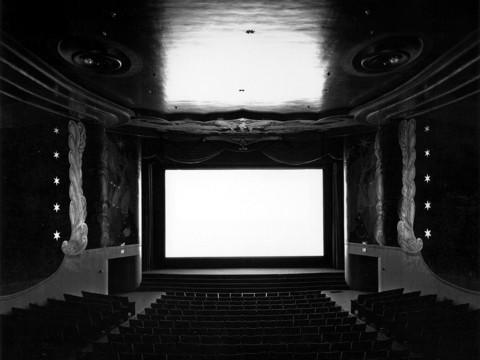
Another photographer whose work I've always thought was very intriguing is Japanese artist, Hiroshi Sugimoto. Unlike my last entry on Larry Clark, my interest in this photographer's work stems directly from the visual aesthetic that the photos have rather than the content in the pictures. The two bodies of work that Sugimoto has done that I find the most interesting are his works done on thaters and a body of work called "Seascapes". The theater project contains many images that look similar to the one I posted above. What sugimoto does is use a very long exposure in the theater while a film of some sort is playing on screen. The result is a bright white screen and a very nicely illuminated theater. Using the light from the screen as the only light in the picture really makes for some interesting light and shadows in the final image.

This next image is from his "Seascape" project. The images come out looking very minimalist. They all consist of 50% ocean and 50% sky, with the horizon line almost directly through the center of the image. Normally I would think that I would get bored of images like this that don't really seem to have too much going on, but there is something about the simple quality in these images that really keep my interest.
http://www.sugimotohiroshi.com/
The theatre project i find extremely interesting. i once had a conversation with my brother about the same project and we got into the idea of how much information is stored in that large white square of light. If you think of the entire movie playing thats two hours (or there about) of visual information, but due to the long exposure it turns into an information-less blob of light. But we concluded that it only adds to the quality of the photo, and even beyond that makes all the very similar photo's in the series unique, even if they are not at first glimpse.
ReplyDeleteI am very intrigued by this photographer's work. I love the use of light. It struck me first in the landscapes, particularly the example shown, that you kind of can't tell where the light source is from...the light seems to splash across the middle in a very satisfying, balanced way. The overexposure is very pleasing and yet you still have your darks at top and bottom. It really highlights the texture of the water versus the smoothness of the sky; I think he's captured that difference in texture on film that we find so soothing in real life. I am a big fan of Japanese water colors and I can see the effect that genre had on this artist...that sense of simple balance, highlighting a tiny aspect of nature.
ReplyDeleteI find the theatre project interesting, too. I love the fact that in the above image, he includes the reflection off the ceiling: it makes you look at a theatre in a different way, adding to your concentration on the screen. I think all these elements speak to our fascination with the movie screen: the top reflection gives the sense of the screen as a pool of water that we're staring into for our own relaxation/rejuvenation---at the same time, as Jon mentions, we're staring at something that becomes an info-less blob, which most times, I think becomes an info-less blob in our minds, too. I think for me it underlines my feeling of the uselessness of the constant inanity of the fare of the TV/movie screen, and all lovely presented in an elaborate setting. I rarely feel, tho, that I want to correct an image---somehow, I think I would have liked to see people in the seats of this particular image.